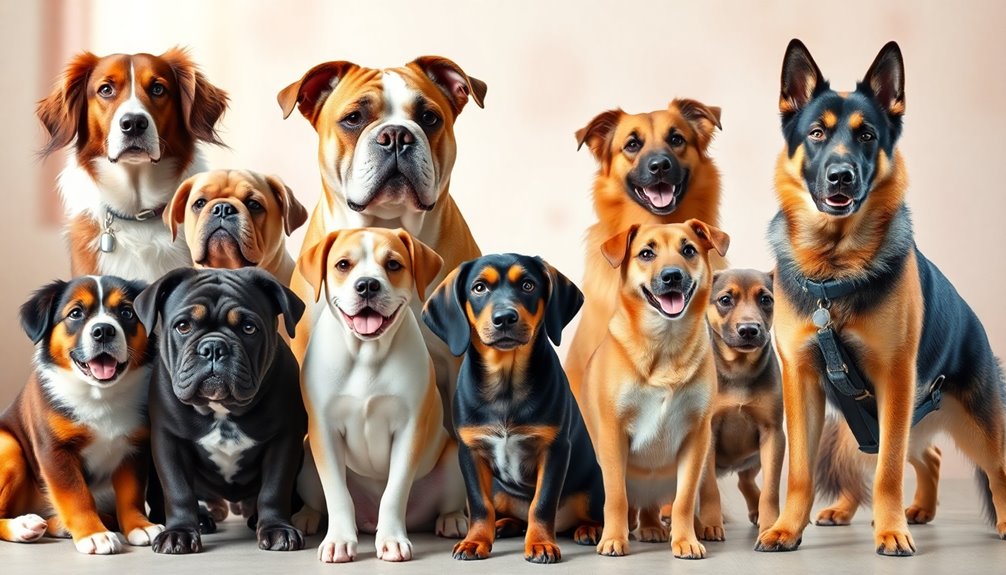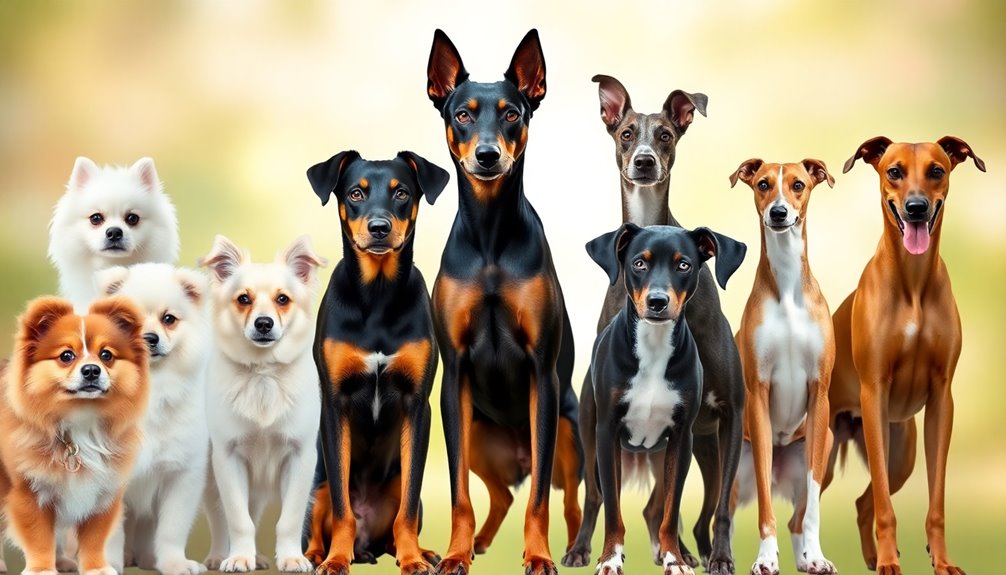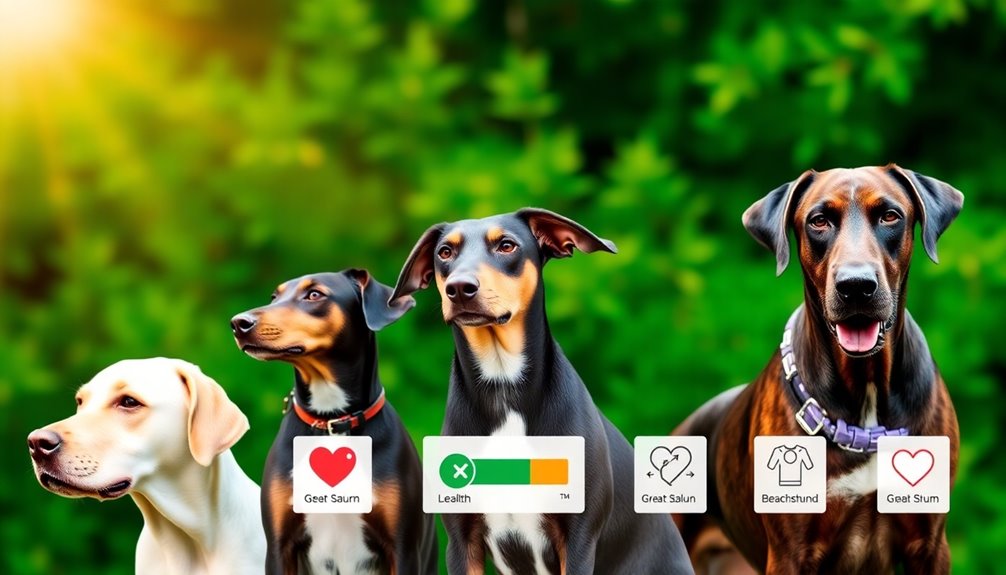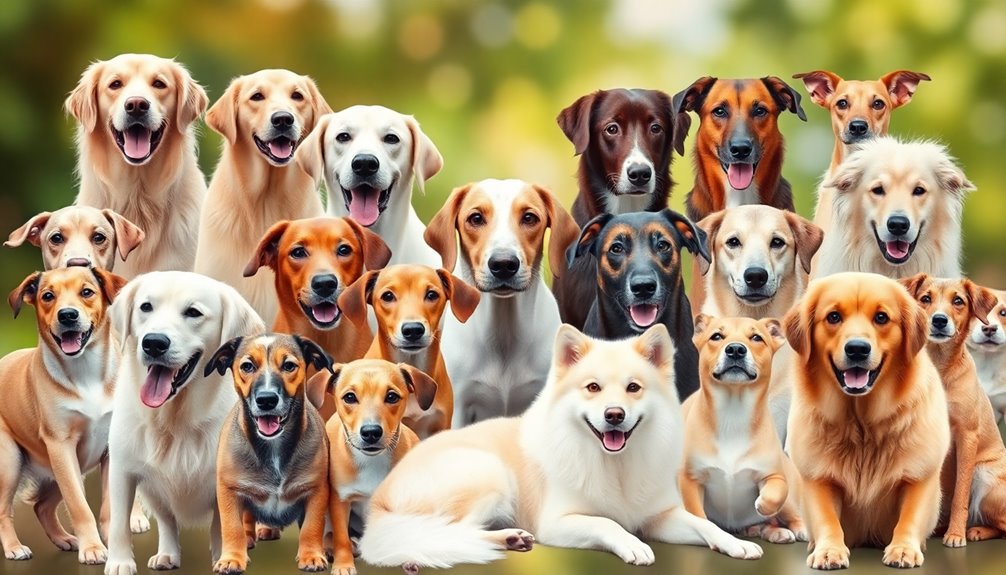You're looking at around 340 recognized dog breeds worldwide. The number varies by organization: the American Kennel Club (AKC) lists 201 breeds, while the Fédération Cynologique Internationale (FCI) includes 360. Each breed serves specific purposes, from companionship to work. Recognizing a breed takes considerable time, as breeders must document its history and form active clubs. Breeds are classified into groups like Sporting, Hound, and Working, based on traits and roles. The diversity and recognition process offer insights into dog development and health. There's much more to explore about dog breeds and their fascinating traits.
Key Takeaways
- There are approximately 340 recognized dog breeds worldwide, varying by different kennel clubs' standards.
- The American Kennel Club (AKC) recognizes 201 breeds, while the Fédération Cynologique Internationale (FCI) lists 360 breeds.
- The UK Kennel Club (KC) acknowledges 222 breeds, and the Australian National Kennel Council (ANKC) maintains breed standards in Australia.
- Breed recognition requires a documented history of at least 40 years and a national breed club with a minimum of 100 active members.
- Dog breeds are classified into groups based on traits and roles, such as Sporting, Hound, Working, and Terrier groups.
Overview of Dog Breeds

When you think about dog breeds, it's fascinating to realize there are around 340 recognized breeds worldwide, each with its unique traits and purposes.
The American Kennel Club recognizes 201 breeds, while the FCI lists 360 and the UKC acknowledges 376. The number of dog breeds varies globally, as different countries may classify the same breed differently.
Some breeds excel as working breeds, fulfilling roles in service and sport, while others are cherished for companionship.
With ongoing selective breeding efforts, the breed standard continually evolves, leading to new recognized breeds.
Understanding these distinctions will help you appreciate the rich diversity among dog breeds and the impact of breeding practices on their development.
Dog Breed Governing Bodies

Dog breed governing bodies play an essential role in maintaining standards and ensuring the integrity of various breeds. Here are some key organizations you should know:
- Fédération Cynologique Internationale (FCI): Represents 84 countries and recognizes 360 dog breeds globally.
- American Kennel Club (AKC): The leading authority in the U.S., recognizing 202 dog breeds and setting breed standards.
- The Kennel Club (KC): Based in the UK, it oversees breed standards and recognizes 222 breeds.
- Australian National Kennel Council (ANKC): Maintains breed standards similar to the AKC and FCI for dog breeds in Australia.
Each body requires a significant population of dogs and an active national breed club to achieve official breed status.
Breed Recognition Process

Gaining recognition for a dog breed can be a complex and lengthy process, often requiring years of dedication from breeders and enthusiasts. To achieve this, a breed must have a documented history of at least 40 years and be recorded with an accepted registry or the AKC Foundation Stock Service. A national breed club with at least 100 active members is also required. Breeds typically start in the Miscellaneous class, which can last three to four years before moving towards full recognition. Additionally, names that reflect the breed's charming personality can enhance their appeal among dog owners.
| Requirement | Details | Timeframe |
|---|---|---|
| Documented History | Minimum of 40 years | 5-8 years |
| Three-Generation Pedigree | 300 to 400 dogs | |
| National Breed Club | Minimum of 100 active members |
Dog Breed Classifications

Recognizing a breed is just the beginning of its journey within the canine community. The American Kennel Club (AKC) classifies dog breeds into seven distinct groups, which helps you understand their unique traits and historical roles.
Here are four key classifications:
- Sporting Group: Breeds like Golden Retrievers and Spaniels, known for hunting and retrieving.
- Hound Group: Includes Beagles and Bloodhounds, celebrated for their tracking abilities.
- Working Group: Features Rottweilers and Siberian Huskies, bred for tasks like guarding and pulling sleds.
- Terrier Group: Energetic breeds like the Scottish Terrier, originally meant for vermin control.
These classifications play a crucial role in dog shows and help you appreciate the diversity of dog breeds.
Health and Lifespan Considerations

When considering a dog breed, it's vital to understand the health and lifespan factors that can greatly impact your pet's quality of life. Lifespan varies considerably; for instance, small breeds like Chihuahuas can live 12-20 years, while larger breeds such as Great Danes may only reach 7-10 years.
Each breed also has its own common health issues—Bulldogs often face respiratory problems, whereas Dachshunds might struggle with back issues. Regular veterinary check-ups are essential for early detection of potential problems. Additionally, understanding the key factors influencing a breed's health can help prospective dog owners make informed decisions based on their lifestyle and the breed's needs.
In addition, genetic testing can reveal breed-specific health risks, guiding responsible breeders in their practices. By prioritizing health screenings, breeders can enhance the lifespan and overall well-being of their dogs, ensuring a happier life for your furry companion.
Adoption and Rescue Options

When you consider adopting a dog, you'll find countless benefits, from saving a life to reducing overpopulation.
Shelters and breed-specific rescue organizations offer a wide variety of options, ensuring you can find the perfect match for your lifestyle.
Plus, mixed-breed dogs often come with added health advantages, making them an excellent choice for many families.
Shelter Adoption Benefits
Adopting a dog from a shelter not only provides a loving home for an animal in need, but it also plays an essential role in addressing the overpopulation crisis many shelters face.
Here are some benefits of shelter adoption:
- Lower Costs: Adoption fees are generally lower than buying from breeders, often covering vaccinations, spaying/neutering, and microchipping.
- Diverse Breeds: You'll find mixed-breed dogs with fewer genetic health issues, leading to potential longevity.
- Tailored Matches: Breed-specific rescues help you find a dog that fits your desired characteristics and lifestyle.
- Education: The adoption process emphasizes understanding a dog's needs, ensuring a successful match between you and your new furry friend.
Choosing adoption not only changes a dog's life but enriches yours too!
Breed-Specific Rescue Organizations
If you're looking for a dog with specific traits, breed-specific rescue organizations offer a tailored approach to adoption that connects you with the right match.
These organizations focus on rehoming dogs of particular breeds, ensuring that potential owners understand their unique requirements. Many are run by passionate volunteers who provide health screenings and temperament assessments, promoting responsible pet ownership.
By adopting from these rescues, you not only gain a loyal companion but also help reduce the number of homeless pets. You contribute to breed welfare through rehabilitation and rehoming efforts, while often receiving valuable resources to support your new dog's needs.
Additionally, many breeds, like the Golden Retriever breed, are known for their friendly temperament, making them great candidates for adoption.
Partnering with breed-specific rescues means making a difference for both you and the dogs in need.
Frequently Asked Questions
How Many Dog Breeds Are There in Total?
You might be surprised to learn that there are around 340 recognized dog breeds worldwide.
Different organizations have varying counts; the American Kennel Club lists 202 breeds, while the Fédération Cynologique Internationale recognizes about 360.
The United Kennel Club and The Kennel Club in Britain also have their own numbers.
Keep in mind that designer dogs and mixed breeds aren't counted among these recognized breeds, focusing solely on distinct, officially recognized types.
How Many Dog Breeds Are There Including Mixed Breeds?
When you think about the total number of dog breeds, including mixed breeds, the numbers skyrocket. While official registries recognize around 340 breeds, countless mixed breeds and hybrids exist, especially with designer dogs like Goldendoodles gaining popularity.
It's estimated that when you factor in all variations, the total could easily surpass several hundred thousand.
What Is the #1 Smartest Dog?
If you're looking for the absolute genius of the dog world, it's got to be the Border Collie!
You'll find no other breed that matches its incredible intelligence and quick learning. These pups can master new commands in just a few tries, which is downright astonishing!
Their agility and problem-solving skills are unmatched, making them the ultimate canine companion for anyone who craves an active and mentally stimulating relationship.
Why Is There 340 Breeds of Dogs?
You might wonder why there are 340 dog breeds. It's mainly due to selective breeding over thousands of years to meet various human needs, like companionship, work, and specific tasks.
Different kennel clubs establish breed standards, leading to unique classifications. Additionally, the rise of designer and hybrid dogs has broadened the definition of breeds, even though these hybrids aren't always formally recognized.
This rich history contributes to the incredible diversity of dog breeds today.
Conclusion
In the vast world of dog breeds, there's a perfect companion waiting for you, like a hidden gem just waiting to be discovered. With so many options, it's crucial to explore breeds and their traits to find your ideal match. Remember, whether you're adopting or considering a specific breed, each dog has its own unique personality and needs. So plunge into the journey of finding your furry friend—your heart will thank you for it!










